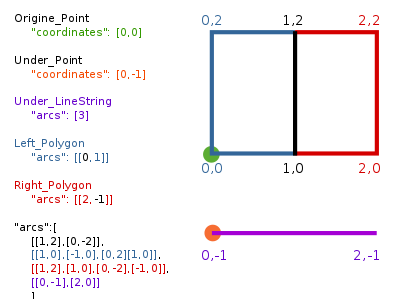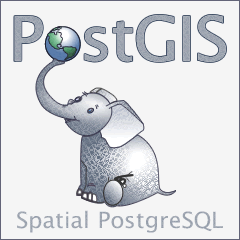Example
{"type":"FeatureCollection","features":[{"type":"Feature","geometry":{"type":"Point","coordinates":[102.0,0.5]},"properties":{"prop0":"value0"}},{"type":"Feature","geometry":{"type":"LineString","coordinates":[[102.0,0.0],[103.0,1.0],[104.0,0.0],[105.0,1.0]]},"properties":{"prop0":"value0","prop1":0.0}},{"type":"Feature","geometry":{"type":"Polygon","coordinates":[[[100.0,0.0],[101.0,0.0],[101.0,1.0],[100.0,1.0],[100.0,0.0]]]},"properties":{"prop0":"value0","prop1":{"this":"that"}}}]}Geometries
Points are [x, y] or [x, y, z]. They may be [longitude, latitude] or [eastings, northings]. Elevation, in meters [6] , is an optional third number. They are decimal numbers. [7]
For example, London (51.5074° North, 0.1278° West) is [-0.1278, 51.5074]
| Type | Examples | |
|---|---|---|
| Point |  | {"type":"Point","coordinates":[30.0,10.0]} |
| LineString |  | {"type":"LineString","coordinates":[[30.0,10.0],[10.0,30.0],[40.0,40.0]]} |
| Polygon |  | {"type":"Polygon","coordinates":[[[30.0,10.0],[40.0,40.0],[20.0,40.0],[10.0,20.0],[30.0,10.0]]]} |
 | {"type":"Polygon","coordinates":[[[35.0,10.0],[45.0,45.0],[15.0,40.0],[10.0,20.0],[35.0,10.0]],[[20.0,30.0],[35.0,35.0],[30.0,20.0],[20.0,30.0]]]} | |
| Type | Examples | |
|---|---|---|
| MultiPoint |  | {"type":"MultiPoint","coordinates":[[10.0,40.0],[40.0,30.0],[20.0,20.0],[30.0,10.0]]} |
| MultiLineString |  | {"type":"MultiLineString","coordinates":[[[10.0,10.0],[20.0,20.0],[10.0,40.0]],[[40.0,40.0],[30.0,30.0],[40.0,20.0],[30.0,10.0]]]} |
| MultiPolygon |  | {"type":"MultiPolygon","coordinates":[[[[30.0,20.0],[45.0,40.0],[10.0,40.0],[30.0,20.0]]],[[[15.0,5.0],[40.0,10.0],[10.0,20.0],[5.0,10.0],[15.0,5.0]]]]} |
 | {"type":"MultiPolygon","coordinates":[[[[40.0,40.0],[20.0,45.0],[45.0,30.0],[40.0,40.0]]],[[[20.0,35.0],[10.0,30.0],[10.0,10.0],[30.0,5.0],[45.0,20.0],[20.0,35.0]],[[30.0,20.0],[20.0,15.0],[20.0,25.0],[30.0,20.0]]]]} | |
| GeometryCollection |  | {"type":"GeometryCollection","geometries":[{"type":"Point","coordinates":[40.0,10.0]},{"type":"LineString","coordinates":[[10.0,10.0],[20.0,20.0],[10.0,40.0]]},{"type":"Polygon","coordinates":[[[40.0,40.0],[20.0,45.0],[45.0,30.0],[40.0,40.0]]]}]} |









